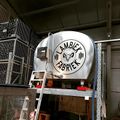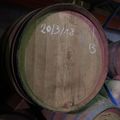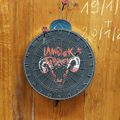Lambiek Fabriek: Difference between revisions
No edit summary |
|||
| (50 intermediate revisions by 5 users not shown) | |||
| Line 1: | Line 1: | ||
[[File:Logo Lambiek Fabriek - lambiekfabriek vof.png| | [[File:Logo Lambiek Fabriek - lambiekfabriek vof.png|400px|right]] | ||
'''Website:''' http://www.lambiekfabriek.be/ | '''Website:''' http://www.lambiekfabriek.be/ | ||
''' | '''Instagram:''' @lambiek_fabriek | ||
'''Address:''' | '''Contact:''' [mailto:info@lambiekfabriek.be info@lambiekfabriek.be] | ||
'''Address:''' Eugène Ghijsstraat 71, 1600 Sint-Pieters-Leeuw | |||
== Overview == | == Overview == | ||
Lambiek Fabriek is a lambic | Lambiek Fabriek is a lambic producer founded by Jo Panneels and Jozef Van Bosstraeten in 2016, and is located in Sint-Pieters-Leeuw. “Fabriek” represents their original brew site in the “Fabriekstraat” in Ruisbroek (Sint-Pieters-Leeuw). The ram skull logo and the round shaped labels were specifically chosen to step away from the classic (paint stripe) labels on the market, thus giving Lambiek Fabriek its own identity. Another feature representing Lambiek Fabriek’s identity on the market is that all of the products in their lineup end with “-Elle”. | ||
== History== | == History== | ||
[[File:Lambiek Fabriek | [[File:Lambiek Fabriek Jozef and Jo.jpg|Jozef Van Bosstraeten & Jo Panneels|thumb|left]] | ||
Jo Panneels and Jozef Van Bosstraeten raised the idea of starting their own lambic brewery whilst drinking geuze in a café in the Pajottenland. Back in the mid-2000s, Jo Panneels worked in the retail business and Jozef Van Bosstraeten worked as a plasterer. Each year the two friends (who have known each other since childhood) went to France to help the winemakers with the grape harvest in the Burgundy region. The winemakers were intrigued when they found out about the friends’ lambic project, and offered some oak barrels of both 400 L and 220 L sizes. Lambic wort could relatively easily be sourced around the mid-2000s, because it was not as popular as it is nowadays. The Lambiek Fabriek founders had not grown up in a brewing family, but gained their technical beer knowledge by taking professional classes in COOVI Anderlecht, which is a school specialized in the catering industry. | |||
A two stories high garage in the Fabriekstraat in Ruisbroek (one of three villages part of the municipality of Sint-Pieters-Leeuw) was transformed into a warehouse where Jo & Jozef could produce their first lambic around 2006–07. Between 2008 and 2015, the future Lambiek Fabriek founders purchased some wort, young lambic, and old lambic a first time from [[Brouwerij_Girardin|Girardin]], then from: [[Brouwerij_Lindemans|Lindemans]], [[Brouwerij_3_Fonteinen|3 Fonteinen]], [[Brouwerij Oud Beersel]], and [[Hanssens Artisanaal bvba]]. They began to experiment making only kriek lambic in small 20 L and 60 L carboys for non-commercial use. While beginning to contemplate the logistics of blending lambic commercially, lambic was at the same time in one of its most popular and rapid upswings in popularity. This made the market for lambic wort from other producers much tighter due to demand at their own breweries and blenderies, as well as making any available wort more expensive. | |||
By 2015, the decision had been made to start a new commercial-sized lambic brewery. Their tasks were quickly defined because the two friends know each other for over 30 years and know how to work complementary. They agreed on Jozef Van Bosstraeten taking on the role of master brewer, and Jo Panneels as zythologist assisting in blending and responsible for all non-production tasks such as: finance, sales & marketing distribution,... Given the fact that they were not able to purchase wort from the bigger lambic brewers at the time, Jo Paneels approached the clean top fermentation brewery Belgoo in Zuun (Sint-Pieters-Leeuw) to let Lambiek Fabriek brew lambic on-premises. In the beginning of the brewing sessions, the coolship was not present at the brewery. Instead, it was located at their original warehouse in Ruisbroek, approximately 3 km away from the brewery. The first two seasons (2015-16 and 2016-17), freshly brewed wort was transported approximately 4.5 km away from the brewery to another warehouse where it was pumped into the coolship to cool overnight. Logistically, this was a strain. To solve the problem of having spontaneous fermentation alongside a clean brewery, a separate warehouse was chosen on-site to house the barrels and all of the necessary pumps and hoses. Eventually, it was decided that the coolship should be moved to the brewery for logistical reasons, and it was installed under a roof outside of the brewery in the fall of 2017 so as to not interfere with the clean fermentation at the brewery. | |||
[[File:Lambiek Fabriek barrel room Ruisbroek.jpg|Lambiek Fabriek’s barrel room in Ruisbroek|thumb|right]] | |||
In 2020, Lambiek Fabriek also joined [[HORAL|HORAL]], a non-profit organization that groups the lambic producers in the Pajottenland and the Valley of the Senne. The [[HORAL|HORAL]] Megablend 2021 and 2022 both contain lambic brewed by Lambiek Fabriek. A relocation to a new and bigger warehouse became necessary, and after finding a place in Eugène Ghijsstraat 71, Lambiek Fabriek’s main site is once again in Ruisbroek since December 2021. | |||
The site was used originally for storage and bottling, whereas the garage warehouse where it all started over a decade ago was used a few years more to store barrels. Fruits and bottles were stored in a warehouse in Lot (Beersel). | |||
For the 2021–22 and 2022-23 seasons, as they vacated Belgoo's building where they were sharing equipment, Jozef Van Bosstraeten brewed Lambiek Fabriek's lambic by making use of other lambic producers' brewing equipment at their brew sites, being: [[Brouwerij_De_Troch|De Troch]], [[Brouwerij_3_Fonteinen|3 Fonteinen]], [[Den_Herberg|Den Herberg]] and [[Brouwerij_Lindemans|Lindemans]]. The products in the lineup during 2021-22 are all blends from the aforementioned 4 lambic breweries, as well as Lambiek Fabriek's own brewed lambic that was produced at their previous brew site in Zuun. During the 2022-23 season, it was a blend of their own lambic as well as De Troch and Lindemans. | |||
[[ | |||
In 2023, a full brewhouse with a capacity of 20 hectoliters was purchased and installed in the warehouse (now hosting the entire operation, from barrel and fruit storage to bottling and brewing), with a first brew in March 2024. They also purchased two milk tanks of 3500L and 5000L for blending. From season 2023/24, all the of releases by Lambiek Fabriek used exclusively their own lambic, and they even provided different blenders; including Dust, Dock, Pellicle Vergistingen, Hannsens, Odilon and Pouckie Blended as well as Misery brewery for a hybrid beer. | |||
==Brewing and Blending Process== | ==Brewing and Blending Process== | ||
The lambic | The lambic which Lambiek Fabriek brews is based on a traditional lambic recipe that consists of approximately +/- 35% wheat and +/- 65% malted barley and uses aged pellet hops. The stainless steel coolship that Lambiek Fabriek used in Zuun during the seasons 2016–2021 was fabricated locally and is divided into two equal halves of 1,200 L each, thus a full brew filled the coolship. The wort is then pumped over at approximately 95º C and left to cool until it is transferred over to barrels at around 22-23º C. Jo Panneels assists master brewer Jozef Van Bosstraeten with blending, and each bottling contains 5,000 L. Bottling is done semi-automatically on site in Ruisbroek at a rate of 1,300 bottles per hour. Putting capsules on the bottles is the only manual labor in the bottling process. | ||
Fruits are sourced fresh or frozen, and quantities can change quiet a lot depending of maturity or on the profile of the lambic used for each release, macerations are done and the beer is then blended to taste, there are no hard rules. | |||
Jozef Van Bosstraeten is not only Lambiek Fabriek’s master brewer, but he is also a cooper. Lambiek Fabriek finds it important to have an in-house cooper, in order to maintain the barrels and foeders without needing to rely on an external party. Many of the French oak barrels are first-fill barrels coming from the Burgundy region in France, where Lambiek Fabriek has a connection to some winemakers. | |||
The | In 2022, there was about 210 barrels (180 x 400 liter and 30 x 220 liter sizes) across the two warehouses, as well as 12 foeders which originate from Italy and Austria. All foeders were between 30-40 years old at the time of purchase. The 8 smallest foeders have a capacity of 47 hl each, one of 65 hl, and the 3 biggest foeders can contain 70 hl each. The geuze is a blend of lambic aged in 400 L barrels, whereas the fruit lambics are a combination of lambic aged in barrels (of different sizes) and foeders. Some barrels are marked with a capital “B” to indicate that the lambic inside has been made from organic grains. The 100% organic lambic is for instance used in “Natur-Elle” and “Organic & Wild Black-Belle”. | ||
By 2025, the amount of barrels decreased to about 120, with the intention to not replace most barrels once they become unusable, as they want to focus on foeders which gives them the profile they are looking for and a good consistency (each foeders gives different profiles, but larger quantities allow for larger blends across different beers), it also reduce the amount of transfers and risk of exposure to oxygen and bad infections. They also had over a dozen of whisky barrels (from the belgian Het Anker brewery and distillery in Mechelen), used not only for Colon-Elle, but also for other projects if inspiration strikes. | |||
==Side Notes== | |||
The fact that most of the name of their products ends in -Elle ("She" in French) originates from a back and forth while looking for names, which unconsciously kept circling around one thing: feminine nouns. Indeed, the first ideas were "Dame-Jeanne" (in french, a glass carboy or "demijohn" used to ferment small batches are called "Dame-Jeanne"), then "La Force" ("The strength", with a design displaying a woman's arm with bit muscled topped by a demijohn) which is also a feminine nouns. Same thing with Brett (the wild yeast used in lambic) or the first fruit they used (cherry or "une cerise" in french). Looking at this fact, they decided to go all in with building names around "Elle", starting with Bret-Elle, Jart-Elle and Fontan-Elle. | |||
Lambiek Fabriek is producing a gueuze and a kriek in large batches for Pajottegem, brand created by Roel Janssens (of the café “Café Paddenbroek in Gooik), different from their own. Other than that, they have done occasional small batches on requests under their own labels for restaurants or other professionals who wanted a specific beer. They also sold lambic and wort to hobby and professional blenders during season 2024/2025, and a few barrels resting in the warehouse are actually owned by customer who brought them and requested them to be filled with lambic for future use; though the team look after them and might assist for blending if requested, the resulting beer is not their own anymore. | |||
== Beers == | == Beers == | ||
=== Geuze === | === Geuze === | ||
*[[Bord-Elle Oude Geuze]] | |||
*[[Brett-Elle Oude Geuze]] | *[[Brett-Elle Oude Geuze]] | ||
*[[Colon-Elle Single & Wild]] | |||
*[[Fontan-Elle Young & Wild]] | *[[Fontan-Elle Young & Wild]] | ||
*[[Geuze Pajottegem]] | |||
*[[Natur-Elle Organic Geuze]] | |||
*[[Sporty Geuze Origin-Elle]] | |||
*[[Wild & Peaty Geuze]] | |||
===Fruit=== | |||
*[[Akkurat 30 Years Arctic Bramble]] | |||
*[[Akkurat 30 Years Lingon Berry]] | |||
*[[Blend Muscar-Elle & Blue-Belle]] | |||
*[[Bloody Byron]] | |||
*[[Juicy & Wild Black-Belle]] | |||
*[[Juicy & Wild Blue-Belle]] | |||
*[[Juicy & Wild Frais-Elle]] | |||
*[[Juicy & Wild Gross-Elle]] | |||
*[[Juicy & Wild Malvas-Elle]] | |||
*[[Juicy & Wild Mon-Elle ]] | |||
*[[Juicy & Wild Muri-Elle]] | |||
*[[Juicy & Wild Muscar-Elle]] | |||
*[[Juicy & Wild Pluri-Elle]] | |||
*[[Juicy & Wild Rhub-Elle]] | |||
*[[Juicy & Wild Soleille]] | |||
*[[Kriek Pajottegem]] | |||
*[[Mix-Elle]] | |||
*[[Organic & Wild Black-Belle]] | |||
*[[Oude Kriek Jart-Elle]] | |||
*[[Oude Kriek Schar-Elle]] | |||
*[[Red Currant Lambiek]] | |||
===Lambic=== | |||
*[[Jingle & Wild Noëlle]] | |||
*[[Pale & Wild Caram‑Elle]] | |||
===Herbs/Spices=== | |||
*[[Le Chalet De La Forêt Can-Elle]] | |||
*[[Le Chalet De La Forêt Dragon-Elle]] | |||
*[[Le Chalet De La Forêt Elle-Derflower]] | |||
*[[Le Chalet De La Forêt Green Shiso]] | |||
*[[Le Chalet De La Forêt Pink Shiso]] | |||
===Lambic hybrid blends=== | |||
*[[Ker-Elle Kaishaku Kriek]] | |||
*[[Mix Bloem-Bik]] | |||
== Photos == | == Photos == | ||
<gallery> | <gallery> | ||
File:Lambiek Fabriek | File:Lambiek Fabriek entrance.jpg|Entrance in Ruisbroek | ||
File:Lambiek Fabriek | File:Lambiek Fabriek warehouse Ruisbroek.jpg|Barrel room in Ruisbroek | ||
File:Lambiek Fabriek | File:Lambiek Fabriek barrel room Ruisbroek2.jpg|Barrel room in Ruisbroek | ||
File:Lambiek Fabriek | File:Lambiek Fabriek tank in warehouse.jpg|Warehouse | ||
File: | File:Lambiek Fabriek foeder.jpg|Foeder | ||
File:Lambiek Fabriek | File:Lambiek Fabriek barrel maintenance.jpg|Barrel maintenance | ||
File:Lambiek Fabriek fermentation.JPG|Fermentation | |||
File:Lambiek Fabriek fermentation2.jpg|Fermentation | |||
File:Lambiek Fabriek Organic Lambic.jpg|Barrel of organic lambic | File:Lambiek Fabriek Organic Lambic.jpg|Barrel of organic lambic | ||
File:Lambiek Fabriek tasting blends.jpg|Lambic blends | |||
File:Lambiek Fabriek ram skull.jpg|Ram skull | |||
File:Lambiek Fabriek dart board.jpg|Dart board | |||
</gallery> | </gallery> | ||
Latest revision as of 10:51, 12 November 2025
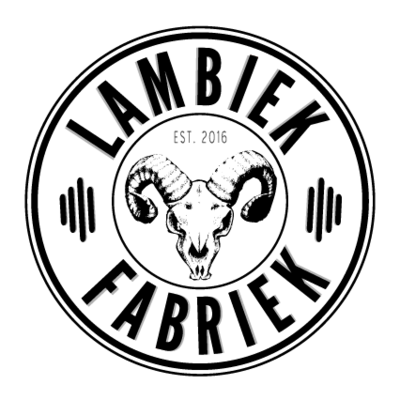
Website: http://www.lambiekfabriek.be/
Instagram: @lambiek_fabriek
Contact: info@lambiekfabriek.be
Address: Eugène Ghijsstraat 71, 1600 Sint-Pieters-Leeuw
Overview
Lambiek Fabriek is a lambic producer founded by Jo Panneels and Jozef Van Bosstraeten in 2016, and is located in Sint-Pieters-Leeuw. “Fabriek” represents their original brew site in the “Fabriekstraat” in Ruisbroek (Sint-Pieters-Leeuw). The ram skull logo and the round shaped labels were specifically chosen to step away from the classic (paint stripe) labels on the market, thus giving Lambiek Fabriek its own identity. Another feature representing Lambiek Fabriek’s identity on the market is that all of the products in their lineup end with “-Elle”.
History
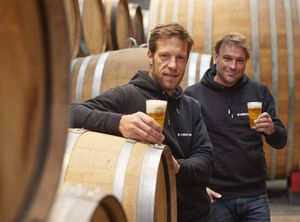
Jo Panneels and Jozef Van Bosstraeten raised the idea of starting their own lambic brewery whilst drinking geuze in a café in the Pajottenland. Back in the mid-2000s, Jo Panneels worked in the retail business and Jozef Van Bosstraeten worked as a plasterer. Each year the two friends (who have known each other since childhood) went to France to help the winemakers with the grape harvest in the Burgundy region. The winemakers were intrigued when they found out about the friends’ lambic project, and offered some oak barrels of both 400 L and 220 L sizes. Lambic wort could relatively easily be sourced around the mid-2000s, because it was not as popular as it is nowadays. The Lambiek Fabriek founders had not grown up in a brewing family, but gained their technical beer knowledge by taking professional classes in COOVI Anderlecht, which is a school specialized in the catering industry.
A two stories high garage in the Fabriekstraat in Ruisbroek (one of three villages part of the municipality of Sint-Pieters-Leeuw) was transformed into a warehouse where Jo & Jozef could produce their first lambic around 2006–07. Between 2008 and 2015, the future Lambiek Fabriek founders purchased some wort, young lambic, and old lambic a first time from Girardin, then from: Lindemans, 3 Fonteinen, Brouwerij Oud Beersel, and Hanssens Artisanaal bvba. They began to experiment making only kriek lambic in small 20 L and 60 L carboys for non-commercial use. While beginning to contemplate the logistics of blending lambic commercially, lambic was at the same time in one of its most popular and rapid upswings in popularity. This made the market for lambic wort from other producers much tighter due to demand at their own breweries and blenderies, as well as making any available wort more expensive.
By 2015, the decision had been made to start a new commercial-sized lambic brewery. Their tasks were quickly defined because the two friends know each other for over 30 years and know how to work complementary. They agreed on Jozef Van Bosstraeten taking on the role of master brewer, and Jo Panneels as zythologist assisting in blending and responsible for all non-production tasks such as: finance, sales & marketing distribution,... Given the fact that they were not able to purchase wort from the bigger lambic brewers at the time, Jo Paneels approached the clean top fermentation brewery Belgoo in Zuun (Sint-Pieters-Leeuw) to let Lambiek Fabriek brew lambic on-premises. In the beginning of the brewing sessions, the coolship was not present at the brewery. Instead, it was located at their original warehouse in Ruisbroek, approximately 3 km away from the brewery. The first two seasons (2015-16 and 2016-17), freshly brewed wort was transported approximately 4.5 km away from the brewery to another warehouse where it was pumped into the coolship to cool overnight. Logistically, this was a strain. To solve the problem of having spontaneous fermentation alongside a clean brewery, a separate warehouse was chosen on-site to house the barrels and all of the necessary pumps and hoses. Eventually, it was decided that the coolship should be moved to the brewery for logistical reasons, and it was installed under a roof outside of the brewery in the fall of 2017 so as to not interfere with the clean fermentation at the brewery.

In 2020, Lambiek Fabriek also joined HORAL, a non-profit organization that groups the lambic producers in the Pajottenland and the Valley of the Senne. The HORAL Megablend 2021 and 2022 both contain lambic brewed by Lambiek Fabriek. A relocation to a new and bigger warehouse became necessary, and after finding a place in Eugène Ghijsstraat 71, Lambiek Fabriek’s main site is once again in Ruisbroek since December 2021.
The site was used originally for storage and bottling, whereas the garage warehouse where it all started over a decade ago was used a few years more to store barrels. Fruits and bottles were stored in a warehouse in Lot (Beersel).
For the 2021–22 and 2022-23 seasons, as they vacated Belgoo's building where they were sharing equipment, Jozef Van Bosstraeten brewed Lambiek Fabriek's lambic by making use of other lambic producers' brewing equipment at their brew sites, being: De Troch, 3 Fonteinen, Den Herberg and Lindemans. The products in the lineup during 2021-22 are all blends from the aforementioned 4 lambic breweries, as well as Lambiek Fabriek's own brewed lambic that was produced at their previous brew site in Zuun. During the 2022-23 season, it was a blend of their own lambic as well as De Troch and Lindemans.
In 2023, a full brewhouse with a capacity of 20 hectoliters was purchased and installed in the warehouse (now hosting the entire operation, from barrel and fruit storage to bottling and brewing), with a first brew in March 2024. They also purchased two milk tanks of 3500L and 5000L for blending. From season 2023/24, all the of releases by Lambiek Fabriek used exclusively their own lambic, and they even provided different blenders; including Dust, Dock, Pellicle Vergistingen, Hannsens, Odilon and Pouckie Blended as well as Misery brewery for a hybrid beer.
Brewing and Blending Process
The lambic which Lambiek Fabriek brews is based on a traditional lambic recipe that consists of approximately +/- 35% wheat and +/- 65% malted barley and uses aged pellet hops. The stainless steel coolship that Lambiek Fabriek used in Zuun during the seasons 2016–2021 was fabricated locally and is divided into two equal halves of 1,200 L each, thus a full brew filled the coolship. The wort is then pumped over at approximately 95º C and left to cool until it is transferred over to barrels at around 22-23º C. Jo Panneels assists master brewer Jozef Van Bosstraeten with blending, and each bottling contains 5,000 L. Bottling is done semi-automatically on site in Ruisbroek at a rate of 1,300 bottles per hour. Putting capsules on the bottles is the only manual labor in the bottling process.
Fruits are sourced fresh or frozen, and quantities can change quiet a lot depending of maturity or on the profile of the lambic used for each release, macerations are done and the beer is then blended to taste, there are no hard rules.
Jozef Van Bosstraeten is not only Lambiek Fabriek’s master brewer, but he is also a cooper. Lambiek Fabriek finds it important to have an in-house cooper, in order to maintain the barrels and foeders without needing to rely on an external party. Many of the French oak barrels are first-fill barrels coming from the Burgundy region in France, where Lambiek Fabriek has a connection to some winemakers.
In 2022, there was about 210 barrels (180 x 400 liter and 30 x 220 liter sizes) across the two warehouses, as well as 12 foeders which originate from Italy and Austria. All foeders were between 30-40 years old at the time of purchase. The 8 smallest foeders have a capacity of 47 hl each, one of 65 hl, and the 3 biggest foeders can contain 70 hl each. The geuze is a blend of lambic aged in 400 L barrels, whereas the fruit lambics are a combination of lambic aged in barrels (of different sizes) and foeders. Some barrels are marked with a capital “B” to indicate that the lambic inside has been made from organic grains. The 100% organic lambic is for instance used in “Natur-Elle” and “Organic & Wild Black-Belle”.
By 2025, the amount of barrels decreased to about 120, with the intention to not replace most barrels once they become unusable, as they want to focus on foeders which gives them the profile they are looking for and a good consistency (each foeders gives different profiles, but larger quantities allow for larger blends across different beers), it also reduce the amount of transfers and risk of exposure to oxygen and bad infections. They also had over a dozen of whisky barrels (from the belgian Het Anker brewery and distillery in Mechelen), used not only for Colon-Elle, but also for other projects if inspiration strikes.
Side Notes
The fact that most of the name of their products ends in -Elle ("She" in French) originates from a back and forth while looking for names, which unconsciously kept circling around one thing: feminine nouns. Indeed, the first ideas were "Dame-Jeanne" (in french, a glass carboy or "demijohn" used to ferment small batches are called "Dame-Jeanne"), then "La Force" ("The strength", with a design displaying a woman's arm with bit muscled topped by a demijohn) which is also a feminine nouns. Same thing with Brett (the wild yeast used in lambic) or the first fruit they used (cherry or "une cerise" in french). Looking at this fact, they decided to go all in with building names around "Elle", starting with Bret-Elle, Jart-Elle and Fontan-Elle.
Lambiek Fabriek is producing a gueuze and a kriek in large batches for Pajottegem, brand created by Roel Janssens (of the café “Café Paddenbroek in Gooik), different from their own. Other than that, they have done occasional small batches on requests under their own labels for restaurants or other professionals who wanted a specific beer. They also sold lambic and wort to hobby and professional blenders during season 2024/2025, and a few barrels resting in the warehouse are actually owned by customer who brought them and requested them to be filled with lambic for future use; though the team look after them and might assist for blending if requested, the resulting beer is not their own anymore.
Beers
Geuze
- Bord-Elle Oude Geuze
- Brett-Elle Oude Geuze
- Colon-Elle Single & Wild
- Fontan-Elle Young & Wild
- Geuze Pajottegem
- Natur-Elle Organic Geuze
- Sporty Geuze Origin-Elle
- Wild & Peaty Geuze
Fruit
- Akkurat 30 Years Arctic Bramble
- Akkurat 30 Years Lingon Berry
- Blend Muscar-Elle & Blue-Belle
- Bloody Byron
- Juicy & Wild Black-Belle
- Juicy & Wild Blue-Belle
- Juicy & Wild Frais-Elle
- Juicy & Wild Gross-Elle
- Juicy & Wild Malvas-Elle
- Juicy & Wild Mon-Elle
- Juicy & Wild Muri-Elle
- Juicy & Wild Muscar-Elle
- Juicy & Wild Pluri-Elle
- Juicy & Wild Rhub-Elle
- Juicy & Wild Soleille
- Kriek Pajottegem
- Mix-Elle
- Organic & Wild Black-Belle
- Oude Kriek Jart-Elle
- Oude Kriek Schar-Elle
- Red Currant Lambiek
Lambic
Herbs/Spices
- Le Chalet De La Forêt Can-Elle
- Le Chalet De La Forêt Dragon-Elle
- Le Chalet De La Forêt Elle-Derflower
- Le Chalet De La Forêt Green Shiso
- Le Chalet De La Forêt Pink Shiso
Lambic hybrid blends
Photos
-
Entrance in Ruisbroek
-
Barrel room in Ruisbroek
-
Barrel room in Ruisbroek
-
Warehouse
-
Foeder
-
Barrel maintenance
-
Fermentation
-
Fermentation
-
Barrel of organic lambic
-
Lambic blends
-
Ram skull
-
Dart board



